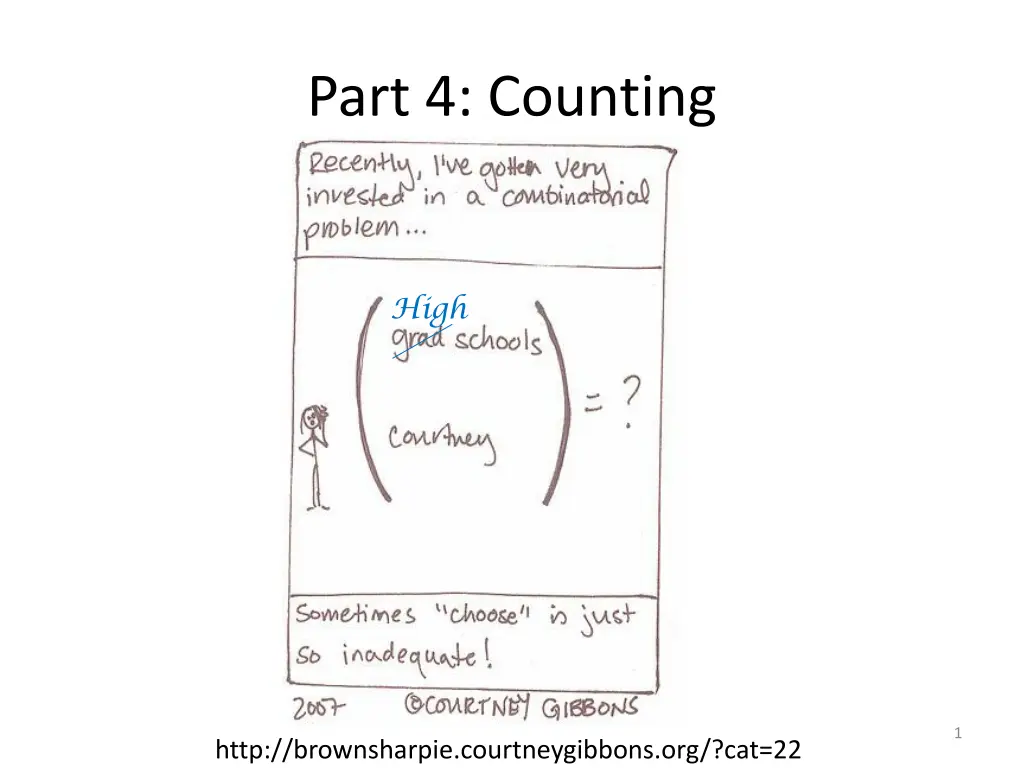
Counting Methods and Examples for Combinations and Permutations
Explore various counting techniques like Permutation, Combination, and Ordered Partition, along with examples such as Sampling With Replacement and Stars and Bars method. Learn how to calculate possible unordered pairs, samples, and ordered partitions efficiently.
Download Presentation

Please find below an Image/Link to download the presentation.
The content on the website is provided AS IS for your information and personal use only. It may not be sold, licensed, or shared on other websites without obtaining consent from the author. If you encounter any issues during the download, it is possible that the publisher has removed the file from their server.
You are allowed to download the files provided on this website for personal or commercial use, subject to the condition that they are used lawfully. All files are the property of their respective owners.
The content on the website is provided AS IS for your information and personal use only. It may not be sold, licensed, or shared on other websites without obtaining consent from the author.
E N D
Presentation Transcript
Part 4: Counting High 1 http://brownsharpie.courtneygibbons.org/?cat=22
Ways of Counting with Replacement without Replacement Permutation (nPr) BCR (Tree diagram) order matters order does not matter SB (Stars and Bars) Combination (nCr) n = # of objects to choose from r = # of objects that we actually choose 2
Sampling With Replacement, order does not matter (SB) Suppose that a sample of size 2 is drawn with replacement from a population of size 5. a) Use a direct listing to determine the number of possible unordered pairs. aa ca ea ab cb eb ac cc ec ad cd ed ae ce ee ba da bb db bc dc bd dd be de b) Determine the number of possible unordered samples of size r with replacement from a population of size n. 6
SB: Examples a) How many different sets of non-negative numbers x, y and z are solutions for the following equation: x + y + z = 136. b) How many ways are there to buy 13 bagels from 17 types if you can repeat the types of bagels? 7
Ordered Partition - Definition An ordered partition of n objects into r distinct groups of sizes n1, n2, , nr is any division of the n objects into a combination (unordered) of n1 objects in the first group, n2 objects in the second group, etc. ? This number is denoted by ?1.?2, ,?? 9
Ordered Partition: Example a) List all of the possible ordered partitions of these 5 letters into two distinct groups of sizes 3 and 2. {abc},{de} {abd},{ce} {abe},{cd} {acd},{be} {ace},{bd} {ade},{bc} {bcd},{ae} {bce},{ad} {bde},{ac} {cde},{ab} b) Use part (a) to determine the number of possible ordered partitions of the 5 letters into the two groups. c) Use the combinations rule and BCR to determine the number of possible ordered partitions of the 5 letters into the 2 groups. 10
Ordered Partition - formula Let n1, n2, , nr be nonnegative integers where ?1+ ?2+ + ??= ?. The number of possible ordered partitions of n objects into r distinct groups of sizes n1, n2, , nr is ? ?1,?2, ?? ?! = ?1!?2! ??! 11
Coincidences Once we set aside coincidences having apparent causes, four principles account for large numbers of remaining coincidences: hidden cause; psychology, including memory and perception; multiplicity of endpoints, including the counting of "close" or nearly alike events as if they were identical; and the law of truly large numbers, which says that when enormous numbers of events and people and their interactions cumulate over time, almost any outrageous event is bound to occur. These sources account for much of the force of synchronicity. (Abstract) .. The probability problems discussed in Section 7 make the point that in many problems our intuitive grasp of the odds is far off. We are often surprised by things that turn out to be fairly likely occurrences. (Introduction) Diaconis, P. and Mosteller, F. "Methods for Studying Coincidences." J. Amer. Statist. Assoc.84, 853-861, 1989 13
